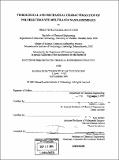Tribological and mechanical characterizations of polyelectrolyte multilayer nanoassemblies
Author(s)
Pavoor, Prem Venkatachalam
DownloadFull printable version (11.76Mb)
Other Contributors
Massachusetts Institute of Technology. Dept. of Chemical Engineering.
Advisor
Robert E. Cohen and Anuj Bellare.
Terms of use
Metadata
Show full item recordAbstract
Over the last decade, the sequential layer-by-layer assembly of oppositely charged polyelectrolytes has received much interest for the deposition of film architectures, ranging from tens to hundreds of nanometers in thickness, that can be precisely tuned as a function of the processing conditions. The resulting polyelectrolyte multilayer (PEM) constructs are being investigated as biomaterials, photonic structures, electrochemical devices, and separation membranes. There is a distinct lack of literature, however, on the friction-and-wear behavior of these nanocoatings, and their exploitation in systems with tribological problems of practical relevance. In addition, their mechanical properties, crucial for the success of almost all applications being studied, have not been systematically characterized. This thesis focuses on the elucidation of the tribological and mechanical properties of PEMs composed predominantly of weak polyelectrolytes--poly(allylamine hydrochloride) (PAH) and poly(acrylic acid) (PAA). In general, the friction coefficients of PAH/PAA PEM-coated substrates were at least marginally higher than those exhibited by their uncoated counterparts, in the absence of substrate wear. The films, however, demonstrated a significant capacity for wear prevention of underlying substrates in the dry state, and also in the presence of bovine calf serum, used to simulate joint synovial fluid. In the latter case, a significant decrease in wear rates, in tests using a clinically relevant number of cycles and articulation pattern, pointed to the efficacy of PEM-coated systems for wear reduction in total joint replacement prostheses; wear particle- induced implant loosening remains a major cause of revision surgeries. (cont.) To tune the frictional response of PEMs without compromising their wear-retarding behavior, various strategies were explored; these included surface capping with a block co-polymer, in-situ synthesis of silver nanoparticles in the films, and assembly of composites containing PAH and multi-wall carbon nanotubes. The engineered coatings find possible applications in microelectromechanical systems (MEMS) where friction, wear, and stiction can be detrimental to device performance. Nanoindentation was employed to probe the mechanical behavior of these ultra-thin films. It was demonstrated that the modulus and hardness of PAH/PAA PEMs could be tuned as a function of the pH of the polyelectrolyte solutions used for their assembly. The mechanical response of these structures was superior to either parent polyelectrolyte and also commercially used polymeric systems. The mechanical properties were studied at ambient conditions and in the presence of a liquid medium.
Description
Thesis (Ph. D.)--Massachusetts Institute of Technology, Dept. of Chemical Engineering, June 2005. Includes bibliographical references.
Date issued
2005Department
Massachusetts Institute of Technology. Department of Chemical EngineeringPublisher
Massachusetts Institute of Technology
Keywords
Chemical Engineering.